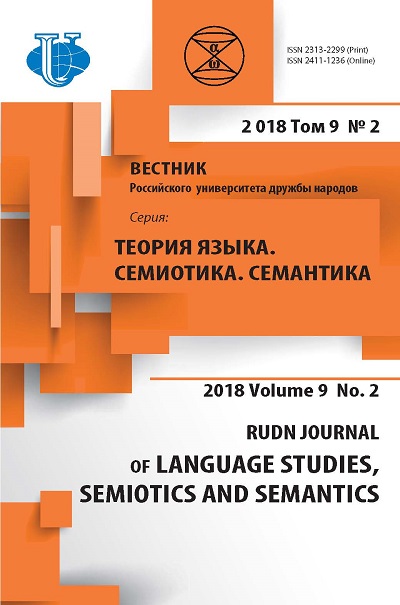EYES AS A MIRROR OF THE SOUL: THE LEXICAL-PHRASEOLOGICAL ASPECT
- Authors: Seliverstova E.I.1
-
Affiliations:
- Saint Petersburg State University
- Issue: Vol 9, No 2 (2018)
- Pages: 388-402
- Section: Functional and Comparative semantics
- URL: https://journals.rudn.ru/semiotics-semantics/article/view/18751
- DOI: https://doi.org/10.22363/2313-2299-2018-9-2-388-402
- ID: 18751
Cite item
Full Text
Abstract
The article considers, on the one hand, phraseological units with the eye-components, capable of characterizing various manifestations of the psychoemotional aspect of the human person, the manner of behavior and the peculiarities of relations between people. In the field of our attention is the nature of the changes observed in the frequency of idioms usage in the speech, and especially in the speech of writers, all range of the used phraseological units, the main vectors of their comprehension. Modern discourse - mostly fragments of the novels and stories - shows the variety of possibilities for using the characteristics of the eyes as a pair organ, as an important attribute of the “decoration” of the face, as a “mirror” capable of hiding / revealing the person’s intentions and thoughts, reflecting mental activity and intellectual abilities or their absence and so on. At the same time for some writers, the reception of the eyes “life” is very important - and not only for creating memorable portraits of characters (with a mention of color, shape and size of the eyes), but also to show a peculiar manner of behavior, character traits, physical or mental state.
Keywords
About the authors
Elena Ivanovna Seliverstova
Saint Petersburg State University
Author for correspondence.
Email: selena754@inbox.ru
Doctor of Philology, Associate Professor, Professor and Acting Head of Russian Language Department for Humanitarian and Natural Faculties, St. Petersburg State University; Interests: phraseology, paremiology, lexicology, text linguistics, Slavic studies, linguistic research
7-9, Universitetskaya emb., Saint-Petersburg, Russia, 199034References
- Ushakov, D.N. (Ed.). (1935—1940). Dictionary of the Russian language. Moscow: “Sov. encycl.”; OGIZ; State publishing house of foreign and national dictionaries. URL: https://dic.academic.ru/ dic.nsf/ushakov/779646 (accessed: 17.02.2018). (In Russ.).
- Evgenieva, A.P. (Ed.) (1983). Dictionary of the Russian language Moscow: Russian language. (In Russ.).
- Leontovich, O.A. (2017). “Mirror, in which each shows his face”: discursive construction of identities. Russian Journal of Linguistics, 21(2), 247—259. (In Russ.).
- Fasmer, M. (2007). Etymological dictionary of the Russian language. Moscow: Astrel: AST. URL: http://www.onlinedics.ru/slovar/fasmer/z/zerkalo.html (accessed: 17.02.2018). (in Russ).
- Krasnykh, V.V. (2002). Ethnopsycholinguistics and linguoculturology: a course of lectures. Moscow: Gnosis. (In Russ.).
- Khayrullina, R.Kh. (1996). A picture of the world in Russian phraseology. Moscow: Prometheus. (In Russ.).
- Vorobyeva, L.B. (2015). National-cultural specificity of phraseological units with eye components in Russian and Lithuanian languages. Socio-Humanitarian Sciences. Issue 1, 145—148. (In Russ.).
- Gorodetskaya, I.E. (2007). Phraseologisms-somatisms in Russian and French: [dissertation]. Pyatigorsk, 2007. URL: http://www.dissercat.com/content/frazeologizmy-somatizmy-v-russkom-i-frantsuzskom-yazykakh (accessed: 17.02.2018). (in Russ.).
- Kovshova, M.L. (2007). The body code of Russian culture: materials for the dictionary. Moscow: Gnosis. (In Russ.).
- Larin, B.A. (2002). The basic principles of the “Dictionary of the autobiographical trilogy M. Gorky” Modern Russian language: Lexicology. Phraseology. Lexicography: Anthology and study assignments. St. Petersburg: Philological Faculty of St. Petersburg State University. pp. 443—450. URL: http://msk-slovar16-17v.slovo-spb.ru/larin0009.htm (accessed: 17.02.2018). (In Russ.).
- Vinogradov V.V. (Ed.) (2000). Dictionary of the language of Pushkin. Moscow: Azbukovnik. (In Russ.).
- Lomakina, O.V. (2009). Phraseographic potential of somaticism “EYE” (on the material of L. Tolstoy’s textology). Problems of history, philology, culture: scientific. Journal of the Russian Academy of Sciences. Issue, 2(24). Moscow—Magnitogorsk—Novosibirsk: Publishing house of “Analitik”. pp. 832—836. (In Russ.).
- Anti-proverbs of the Russian people (2005). Saint-Petersburg: Publishing House “Neva”. (In Russ.).
- Arkhangelskaya, T. (2018). Phraseological image of fear. Slavofraz 2016: Phraseologie und (naïve) Psychologie. Phraseology and (naive) psychology. Grazer Studien zur Slawistik. Band 9. Hamburg: Verlag Dr. Kovač. pp. 217—226. (In Russ.).
- Baranov, A.N. (2014). Descriptor theory of metaphor. Moscow: Languages of Slavic Culture. (In Russ.).
- Fedorov A.I. (Ed.). (1991). Phraseological Dictionary of the Russian literary language of the late XVIII—XX century. Vol. 2. Novosibirsk: Science. (In Russ.).
- Kreidlin, G.E. (2002). Nonverbal semiotics: Body language and natural language. Moscow: New literary review. (In Russ.).
- Kreidlin, G.E. (2014). Semiotic conceptualization of the body and the problem of multimodality. Ecology of language and communicative practice, 2, 100—200. (In Russ.).
- Kreidlin, G. & Pereverzeva, S. (2014). The body in the dialogue: the orientation of somatic objects and the expression of relations between people. Computer linguistics and intellectual technologies: Based on the materials of the International Conference “Dialogue” (Bekasovo, June 4—8, 2014). Vol. 13(20). pp. 272—283. Moscow: RSUH Publ. (In Russ.).
- Krylova, T.V. (2010). The lexicon of «hiding the eyes» (to turn away, to withdraw eyes, to look down, to drop eyes). In: Logical analysis of the language. Mono-, dia-, polylogue in different languages and cultures. Moscow: Indrik. pp. 184—195. (In Russ.).
- Litvinova, V.V. (2009). Individual-author's concepts in the structure of the artistic world of Ray Bradbury: [dissertation]. Krasnodar. URL: http://www.dissercat.com/content (accessed: 17.02.2018). (In Russ.).
- Seliverstova, E.I. (2016). Text from music or music in the text? (D. Rubina’s Novel “The Last Boar from the Forests of Pontevedra”). Philology and Culture. Philology and Culture, 2(44), 131—136. (In Russ.).
- Kozerenko, A. (2018). Strong emotions in the mirror of phraseology: disruption of the functioning of the body systems as a symptom. Slavofraz 2016: Phraseologie und (naïve) Psychologie. Phraseology and (naive) psychology. Grazer Studien zur Slawistik. Band 9. Hamburg: Verlag Dr. Kovač. pp. 315—328. (In Russ.).
- Seliverstova, E.I. (2018). Phraseological units with an eye component as a manifestation of naive psychology. Slavofraz 2016: Phraseologie und (naïve) Psychologie. Phraseology and (naive) psychology. Grazer Studien zur Slawistik. Band 9. Hamburg: Verlag Dr. Kovač. pp. 287—296. (In Russ.).
Supplementary files












